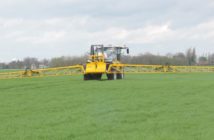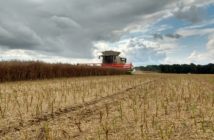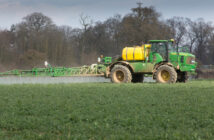BASF Real Results fungicide trials are ripening across the country, and combines will soon start to reveal how wheat crops treated with BASF and competitor products on the 50 farms taking part have fared.
The trials were set up by BASF to test the company’s standard fungicide programme, based on Xemium-based products Adexar and Librax at T1 and T2 respectively, against the farmers’ own choices.
Many farmers have taken the opportunity to use the Real Results trials to compare new SDHIs against BASF’s Xemium products, which over the past few years have staked a claim as the leading wheat fungicides on the market.
Susie Roques, crop physiologist at ADAS, who has been monitoring the Real Results trials across the country, says: “A survey of half the trials shows competitor SDHI products mixed with chlorothalonil were the most common comparison at both T1 and T2.
“The most popular SDHI product was Elatus Era, followed by Ascra Xpro and Aviator Xpro, then others such as Variano and Vertisan.”
Relatively few sites compared cheaper mixtures of azoles and chlorothalonil without SDHIs, says Mrs Roques.
“The inclusion of the latest competitor SDHIs will make Real Results a good all-round test. Most farmers are keen to see how SDHIs stand up against one another, and this is a good opportunity to find out how they perform on their own farms, and more widely under different growing conditions and disease pressures as well.”
Overall, disease has been well controlled in the trials, but dry soils are likely to limit yield potential, especially in the eastern areas of England.
While this might make it difficult to tease out differences between fungicide programmes in some areas, some interesting comparisons are still expected, she adds.
“In general, Septoria tritici and yellow rust have been well controlled in the Real Results trials this year,” says Mrs Roques. “Late disease assessments in our own trials elsewhere confirm that pattern.”
Kind weather at the important T1 and T2 timings enabled most Real Results sprays to be applied at the right time, although some crops did grow away quickly early on, says Mrs Roques. “T1s tended to go on earlier in the east, which kept our site visitors very busy getting around to mark all the sites before sprays were applied.
“The worst Septoria we’ve seen has been in the South West, where rain may have helped spread Septoria to the upper leaves, so timely T2 sprays will have been important.
“Mildew has also been an issue at some of our trial sites across the across the country, while brown rust appeared later on some sites in the east, although it was controlled well where robust fungicide programmes were used.” Most of the sites also received T3 sprays in early-mid June.
The main problem has been early senescence caused by the recent hot, dry weather, she says. “Most crops, especially in the south and east, have senesced about two weeks earlier than usual, and wheat harvest will be starting shortly.
“It is expected that high temperatures recorded in the East and West Midlands during flowering will have reduced grain set in many crops, and early senescence will have curtailed grain filling, so yield expectations are lower than they were a few weeks ago.”
A wide spread of varieties have been used in the trials. “There’s a wide range in the specific varieties used, with no clear regional pattern,” says Mrs Roques. “About half have a Group 4 variety and the rest are split fairly equally between Groups 1 to 3.
“Again, this will help provide a robust test for the fungicide programmes, revealing how they perform over a range of different varietal resistances.”




